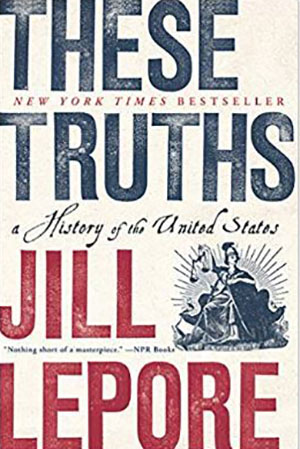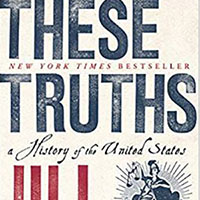— Book review from Jens Kruse —

Jill Lepore, the David Woods Kemper ’41 Professor of American History at Harvard University and a prolific staff writer at The New Yorker, has written a one-volume history of the United States that is important and timely.
The structure of her narrative is as elegant as her writing. Bracketed by an introduction (“The Question Stated”) and an epilogue (“The Question Addressed”) there are four sections: “The Idea” (1492-1799); “The People” (1800-1865); “The State” (1866-1945); and “The Machine” (1946-2016). These sections in turn are subdivided into four chapters each. As a sampler of these chapter titles I will give you the titles of the last chapter of each section: “The Constitution of a Nation;” “The Face of Battle;” “The Brutality of Modernity;” “America, Disrupted.”
Lepore’s history attempts to answer Alexander Hamilton’s question of 1787: “whether societies of men are really capable or not of establishing good government from reflection and choice, or whether they are forever destined to depend for their political constitution on accident and force”? She is well aware that even a book of 789 text pages cannot possibly cover everything, that she must be selective. But she is clear on her principles of selection and her approach to the writing of history. She writes:
In deciding what to leave in and what to leave out, I’ve confined myself to what, in my view, a people constituted as a nation in the early twenty-first century need to know about their past, mainly because this book is meant to double as an old-fashioned civics book, an explanation of the origins and ends of democratic institutions, from the town meeting to the party system, from the nominating convention to the secret ballot, from talk radio to internet polls. (xviii-xix)
She continues:
Aside from being a brief history of the United States and a civics primer, this book aims to be something else, too: it’s an explanation of the nature of the past. History isn’t only a subject; it’s also a method. My method is, generally, to let the dead speak for themselves. I’ve pressed their words between these pages, like flowers, for their beauty, or like insects, for their hideousness. The work of the historian is not the work of the critic or of the moralist; it is the work of the sleuth and the storyteller, the philosopher and the scientist, the keeper of tales, the sayer of sooth, the teller of truth. (xix)
As the title suggests Lepore’s history begins with “these truths,” the truths on which the American experiment rests: “political equality, natural rights, and the sovereignty of the people” (xiv), founding principles, that ever since they were declared have been “cherished, decried, and contested, fought for, fought over, and fought against” (xv). And how could it have been different: “Americans are descended from conquerors and the conquered, from people held as slaves and from the people who held them, from the Union and from the Confederacy, from Protestants and from Jews, from Muslims and from Catholics, and from immigrants and from people who fought to end immigration” (xv-xvi). One of the strands of themes that make up this remarkable book is the history of that contestation.
As Lepore makes clear the very revolution that brought about the founding of the nation emerged from that contestation. She points out:
The Revolution in America, when it came, began not with the English colonists but with the people over whom they ruled. Long before shots were fired at Lexington and Concord, long before George Washington crossed the Delaware, long before American independence was thought of, or even thinkable, a revolutionary tradition was forged , not by the English in America, but by Indians waging wars and slaves waging rebellions. They revolted again and again. Their revolutions came in waves that lashed the land. They asked the same question, unrelentingly. By what right are we ruled? (55)
And so, Lepore reminds us:
There were not one but two American revolutions at the end of the eighteenth century: the struggle for independence from Britain and the struggle to end slavery. Only one was won. (76)
And even after that latter struggle had been won, after a long and bloody civil war, it turned out that that win was not as decisive as it seemed. “Slavery had ended; segregation had only begun” (330). And then, in 1896, there was the jurisprudential abomination of Plessy v. Ferguson:
A century had passed since Jefferson had declared all men equal. Three decades had passed since the Fourteenth Amendment had declared all persons born or naturalized in the United States to be citizens. And now the Supreme Court ruled that those who would set aside equality in favor of separation had not violated the nation’s founding truths. In one of the most wrenching tragedies in American history – a chronicle not lacking for tragedy – the Confederacy had lost the war, but it had won the peace. (360)
It is impossible to describe the richness of Lepore’s narration as she steers her history into the twentieth century and beyond. Suffice it to say that the reader is treated to a history of the political parties, the modernization of industries and society, a history of newspapers and other media, of the nations participation in two world wars, of the tensions between progressives and conservatives, of the struggles of the women’s movement, of the struggle for civil rights and racial equality, and so much more.
At one point, Lepore states that “[s]tability, in American politics, had depended not on the wealth of the few but on the comfort of the many, not on affluence but on security, and a commitment to the notion of the commonwealth” (734). Her book makes clear that that stability, when it is achieved in American history, is precious and precarious, that the forces of imbalance are strong and can be destructive if not checked.
And she leaves no doubt that, as we read her book, we are in a moment of dangerous instability:
Between the attacks of September 11, 2001, and the election of Donald Trump fifteen years later, on November 9, 2016, the United States lost its way in a cloud of smoke. The party system crashed, the press crumbled, and all three branches of government imploded. There was real fear that the American political process was being run by Russians, as if, somehow, the Russians had won the Cold War after all. To observers who included the authors of books like How Democracies End, Why Liberalism Failed, How the Right Lost its Mind, and How Democracies Die, it seemed, as Trump took office, as if the nation might break out in a civil war, as if the American experiment had failed, as if democracy itself was in danger of dying. (729)
In her epilogue, Lepore gives this assessment that makes clear that the questions implicit in “these truths” have not been decided, that they are still open:
The American experiment had not ended. A nation born in revolution will forever struggle against chaos. A nation founded on universal rights will wrestle against the forces of particularism. A nation that toppled a hierarchy of birth only to erect a hierarchy of wealth will never know tranquility. A nation of immigrants cannot close its borders. And a nation born in contradiction, liberty in a land of slavery, sovereignty in a land of conquest, will fight, forever, over the meaning of its history. (786)
These Truths. A History of the United States. (New York: Norton, 2018) can be checked out from the Orcas Library. It is available through Darvill’s Bookstore.
**If you are reading theOrcasonian for free, thank your fellow islanders. If you would like to support theOrcasonian CLICK HERE to set your modestly-priced, voluntary subscription. Otherwise, no worries; we’re happy to share with you.**









Thank you once again for a stimulating review, Jens. I have also read this book, and it is well worth one’s time. Lots of things included that you never came across in your American history textbook.
Wow! Thank you for a very stimulating review. I shall order one forthwith. And it feels important somehow to order it from Darvill’s.
To repurpose a quote:
Culture eats Founding Principles for breakfast.